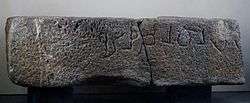Nabataean language
| Nabataean | |
|---|---|
|
Fragment from a dedicatory inscription in Nabataean script to the god Qasiu.[1] | |
| Region | Fertile Crescent |
| Extinct | merged with Arabic during the early Islamic era. |
|
Afro-Asiatic
| |
| Nabataean script | |
| Language codes | |
| ISO 639-3 |
None (mis) |
Linguist list |
qhy |
| Glottolog | None |
The Nabataean language was a western Aramaic dialect and was the language of the Nabataeans of the Negev, east bank of the Jordan, and the Sinai Peninsula.
During the early Islamic era, some Arab historians applied this terms collectively to other eastern Aramaic languages in the Babylonian alluvial plain of Iraq and the Syrian Desert. These areas became Arabized during the Caliphate, and partly before in some areas.
Origin
With the collapse of the Achaemenid Empire (330 BC), the Aramaic language also increasingly lost importance as the lingua franca of the Near East. The Greek language now appeared beside it. The formerly unified written culture fell apart into local schools and the old dialects now also increased in importance as written languages. The Nabataean language was one of these local developments. The language of the Nabataean inscriptions, attested from the 2nd century BC, shows a local development of the Aramaic language. Since the population of the Nabataean Empire may have predominantly spoken a northern Arabic dialect, the Nabataean language may be regarded as principally a written language.
Linguistic classification
The Nabatean language was an offshoot of Imperial Aramaic. With increasing immigration of nomadic Arab tribes, the Nabatean language became increasingly influenced by Arabic. From the Islamic era, the Arabic influence became overwhelming, in a way that it may be said the Nabataean language shifted seamlessly from Aramaic to Arabic.
Evidence
Evidence of Nabataean writings can be found in the Nabataean cities of Petra, Bussra, and Hegra (burial and dedication inscriptions) and there are numerous smaller inscriptions from the southern Sinai peninsula. There are further Nabataean texts from the caves on the Dead Sea.
Script
Nabataean handwriting is characterized by a very characteristic cursive style. The Nabataean alphabet itself developed out of the Aramaic alphabet. It became the precursor of the Arabic alphabet, which developed out of cursive variants of the Nabataean script in the 5th century.
Literature
- al-Khraysheh, Fawwaz: Die Personennamen in den nabatäischen Inschriften des Corpus Inscriptionum Semiticarum. Marburg 1986. In German
- Euting, Julius: Nabatäische Inschriften aus Arabien. Berlin 1885. In German
- Hackl, Ursula/Jenni, Hanna/Schneider, Christoph: Quellen zur Geschichte der Nabatäer. NTOA 51. Fribourg 2003. ISBN 3-7278-1410-1. In German
References
- ↑ Basalt, 1st century CE. Found in Sia in the Hauran, Southern Syria.
| ||||||||||||||||||||||||||||||||||||||||||||||||||||||||||||||||||||||||||||||||||||||||||||||||||||||||||||||||||||||||||||||||||
